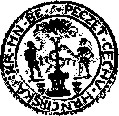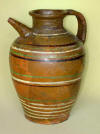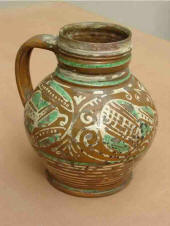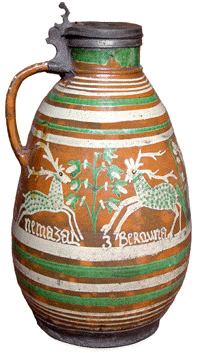|
THE CERAMICS OF BEROUN:
A SIGNIFICANT
REPRESENTATION OF CZECH CERAMICS
FROM THE XV1 AND XV11
CENTURIES
 Beroun’s potters were already well-known
for their skills at the beginning of the 14th century, although the
greatest development in the trade didn’t occur until the 16th and 17th
centuries. The tradition of pottery in and around Beroun continued up
until the 19th century, and today local artisans and artists are beginning
to relate to it once again. The town of Beroun has been organising regular
ceramics markets every autumn since 1997. Due to the high level of
interest, a second gathering of potters and representatives of other
crafts has been taking place each spring since 2003 on Husovo Náměsti.
Thanks to the town of Beroun’s project for the revival of traditional
local ceramics, a project which was initiated by Mr. Vladimir Izbický,
replicas based on archaeological finds have recently begun to be produced.
These are inspired by the techniques of production and the decorative
motifs used at the turn of the 16th and 17th centuries. During the 16th
century, and at the dawn of the 17th century, Beroun’s potters lived
inside the town walls on the streets Česká and Na Klášteře; or, north of
the town along the riverbank, in the suburbs of Rybářské and Horní (also
called Hrnčíské). The products of Beroun’s potters were popular in the
16th and 17th centuries, and were in demand in other parts of Bohemia.
Vilém of Rožemberk and Petr Vok had them brought to Česky Krumlov and
Třeboň, while jugs from Beroun’s potters were already well-known
for their skills at the beginning of the 14th century, although the
greatest development in the trade didn’t occur until the 16th and 17th
centuries. The tradition of pottery in and around Beroun continued up
until the 19th century, and today local artisans and artists are beginning
to relate to it once again. The town of Beroun has been organising regular
ceramics markets every autumn since 1997. Due to the high level of
interest, a second gathering of potters and representatives of other
crafts has been taking place each spring since 2003 on Husovo Náměsti.
Thanks to the town of Beroun’s project for the revival of traditional
local ceramics, a project which was initiated by Mr. Vladimir Izbický,
replicas based on archaeological finds have recently begun to be produced.
These are inspired by the techniques of production and the decorative
motifs used at the turn of the 16th and 17th centuries. During the 16th
century, and at the dawn of the 17th century, Beroun’s potters lived
inside the town walls on the streets Česká and Na Klášteře; or, north of
the town along the riverbank, in the suburbs of Rybářské and Horní (also
called Hrnčíské). The products of Beroun’s potters were popular in the
16th and 17th centuries, and were in demand in other parts of Bohemia.
Vilém of Rožemberk and Petr Vok had them brought to Česky Krumlov and
Třeboň, while jugs from Beroun were used at the coronation of King Matyáš
in Prague in 1611. The magnificence of Beroun’s products is evidenced by a
number of trade disputes between the potters of Beroun and those of Prague
regarding the use of Prague’s markets, a situation which was resolved by
the signing of a contract in 1541. However, in 1560 it became a matter of
judicial proceedings, during which personal assaults occurred, and
products brought from Beroun to Prague were destroyed. A large number of
Beroun’s potters are known from this time: altogether, eight significant
potter dynasties worked in the area between 1523 and 1735, with the
highest concentration occuring between 1540 and 1618. Four more potters
were appointed in the years 1550-1570, and another twelve between 1570 and
1680. The high esteem in which Beroun’s potters were held is proved by the
presence of potter Tomáš Pulec in the post of mayor in the years 1581 and
1582. Potter Jan Kameš was one of the town’s aldermen during the Thirty
Years War, and the Beroun Potter’s Guild was mentioned for the first time
in 1560. However, in the course of the war Beroun was badly damaged, first
by the Saxon invasion of 1634, and later and more seriously by the Swedish
invasion of 1639. The pottery of Beroun was much affected by political and
religious emigration. A series of five fires (in 1564, 1599, 1611, 1635
and 1639) also had a big impact, both on the life of the town and on the
ceramics its artisans produced, while the suburbs of Hrnčířské and
Rybářské are described as “burned down and deserted” in 1651. In this
year, only four potters remained in Beroun, and two of these were
childless. The craft of ceramics was clearly damaged during the Thirty
Years War, yet by the second half of the 17th century its importance had
been regained. This is shown by the fact that there were a high number of
potters on the town council, as well as by the increasing number of
potters exporting their goods to Prague. As the historian Z. Winter
writes: “…and when the people from Beroun bring their pots to the fair
(which they have been doing from ancient times on), they are obliged to
hand over some of load (in Dobřichovice).” The decline in Beroun’s pottery
trade therefore dates from more recent times, and probably didn’t begin
until the 18th century. The production of enamelled metal dishes began at
the end of the 19th century in Nový Jáchzmov, while at the same time the
factories of Beroun were used at the coronation of King Matyáš
in Prague in 1611. The magnificence of Beroun’s products is evidenced by a
number of trade disputes between the potters of Beroun and those of Prague
regarding the use of Prague’s markets, a situation which was resolved by
the signing of a contract in 1541. However, in 1560 it became a matter of
judicial proceedings, during which personal assaults occurred, and
products brought from Beroun to Prague were destroyed. A large number of
Beroun’s potters are known from this time: altogether, eight significant
potter dynasties worked in the area between 1523 and 1735, with the
highest concentration occuring between 1540 and 1618. Four more potters
were appointed in the years 1550-1570, and another twelve between 1570 and
1680. The high esteem in which Beroun’s potters were held is proved by the
presence of potter Tomáš Pulec in the post of mayor in the years 1581 and
1582. Potter Jan Kameš was one of the town’s aldermen during the Thirty
Years War, and the Beroun Potter’s Guild was mentioned for the first time
in 1560. However, in the course of the war Beroun was badly damaged, first
by the Saxon invasion of 1634, and later and more seriously by the Swedish
invasion of 1639. The pottery of Beroun was much affected by political and
religious emigration. A series of five fires (in 1564, 1599, 1611, 1635
and 1639) also had a big impact, both on the life of the town and on the
ceramics its artisans produced, while the suburbs of Hrnčířské and
Rybářské are described as “burned down and deserted” in 1651. In this
year, only four potters remained in Beroun, and two of these were
childless. The craft of ceramics was clearly damaged during the Thirty
Years War, yet by the second half of the 17th century its importance had
been regained. This is shown by the fact that there were a high number of
potters on the town council, as well as by the increasing number of
potters exporting their goods to Prague. As the historian Z. Winter
writes: “…and when the people from Beroun bring their pots to the fair
(which they have been doing from ancient times on), they are obliged to
hand over some of load (in Dobřichovice).” The decline in Beroun’s pottery
trade therefore dates from more recent times, and probably didn’t begin
until the 18th century. The production of enamelled metal dishes began at
the end of the 19th century in Nový Jáchzmov, while at the same time the
factories of
 České Budějovice flooded all of Bohemia with earthenware.
This led to the decline of pottery in Beroun. By the end of the 19th
century, there were only three masters of the once rich and famous guild
left. The last master potter, Vodova ze Zavadilky, stopped his potter’s
wheel at the end of World War II. What are the characteristics of Beroun’s
ceramics, and what makes them so special that we can identify them
definitively amongst archaelogical finds? The answer to these questions is
not easy. In fact, we are talking about a group of products from local
ceramic workshops which have their own characteristic features, both in
terms of the materials used and the specific decorative techniques
employed. We can divide this new age of ceramics, depending on the
structure of ceramic material and its firing, into several different
groups. However, there is no reason to depict this categorisation in great
detail here. For České Budějovice flooded all of Bohemia with earthenware.
This led to the decline of pottery in Beroun. By the end of the 19th
century, there were only three masters of the once rich and famous guild
left. The last master potter, Vodova ze Zavadilky, stopped his potter’s
wheel at the end of World War II. What are the characteristics of Beroun’s
ceramics, and what makes them so special that we can identify them
definitively amongst archaelogical finds? The answer to these questions is
not easy. In fact, we are talking about a group of products from local
ceramic workshops which have their own characteristic features, both in
terms of the materials used and the specific decorative techniques
employed. We can divide this new age of ceramics, depending on the
structure of ceramic material and its firing, into several different
groups. However, there is no reason to depict this categorisation in great
detail here. For
 the purposes of simplification, we will mention only two
basic groups. The most common group of ceramics is that which possesses a
red to red-brown foundation colour, together with decorative lines in
white (in rare cases there are other colour variations, for example
green). The second group is of a grey-whitish tint with fine decorative
shapes. Today, these decorations are done either mechanically, or painted
by hand. The first group of vessels (those with the red foundation),
mainly plates, chalices, jugs and bowls, are decorated in white clay with
a kukačka (an instrument with a reservoir of liquid clay and a thin
nozzle). This group is probably the most attractive part of the collection
as we know it today. Characteristically, the vessels are decorated with
stripes, simple schematic motifs of plants, tree-like motifs, criss-cross
patterns, hearts, rhombuses, crosses and little target patterns, together
with motifs of birds, animals or human figures. The most famous whole
piece which is still in existence is the jug of “Šimon Nemazal from
Beroun”, a vessel decorated by the kukačka technique and dated 1577. This
technique was mainly used on plates, bowls, jugs and chalices, the most
commonly decorated luxury goods. Such a characteristically Beroun
technique and set of motifs is well worth preserving for contemporary and
future times. Don’t you agree? the purposes of simplification, we will mention only two
basic groups. The most common group of ceramics is that which possesses a
red to red-brown foundation colour, together with decorative lines in
white (in rare cases there are other colour variations, for example
green). The second group is of a grey-whitish tint with fine decorative
shapes. Today, these decorations are done either mechanically, or painted
by hand. The first group of vessels (those with the red foundation),
mainly plates, chalices, jugs and bowls, are decorated in white clay with
a kukačka (an instrument with a reservoir of liquid clay and a thin
nozzle). This group is probably the most attractive part of the collection
as we know it today. Characteristically, the vessels are decorated with
stripes, simple schematic motifs of plants, tree-like motifs, criss-cross
patterns, hearts, rhombuses, crosses and little target patterns, together
with motifs of birds, animals or human figures. The most famous whole
piece which is still in existence is the jug of “Šimon Nemazal from
Beroun”, a vessel decorated by the kukačka technique and dated 1577. This
technique was mainly used on plates, bowls, jugs and chalices, the most
commonly decorated luxury goods. Such a characteristically Beroun
technique and set of motifs is well worth preserving for contemporary and
future times. Don’t you agree?
džbán Šimona Nemazala z Berouna
z roku 1577 - 57 cm vysoký
|